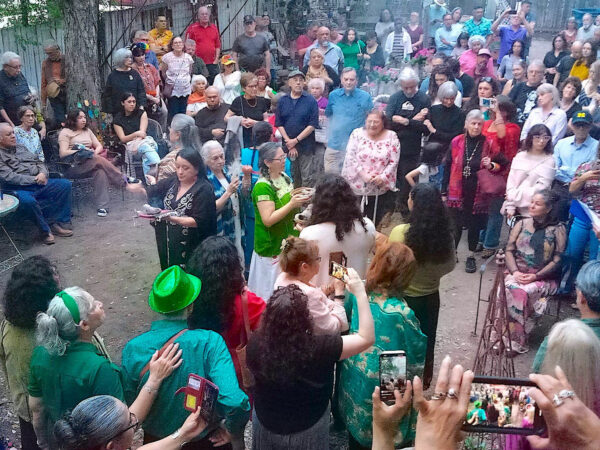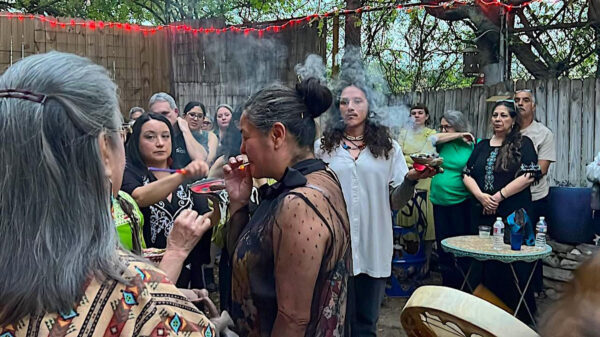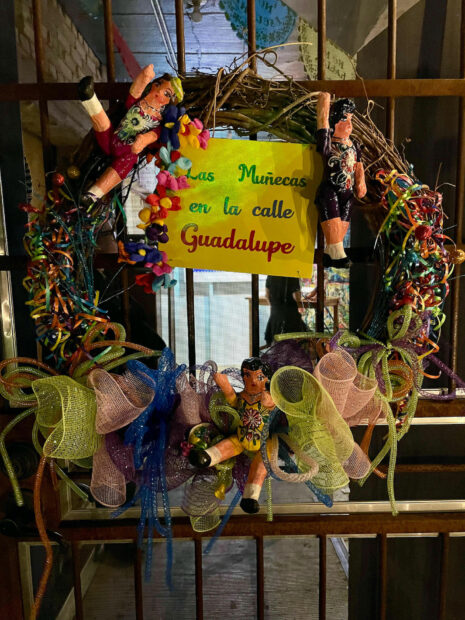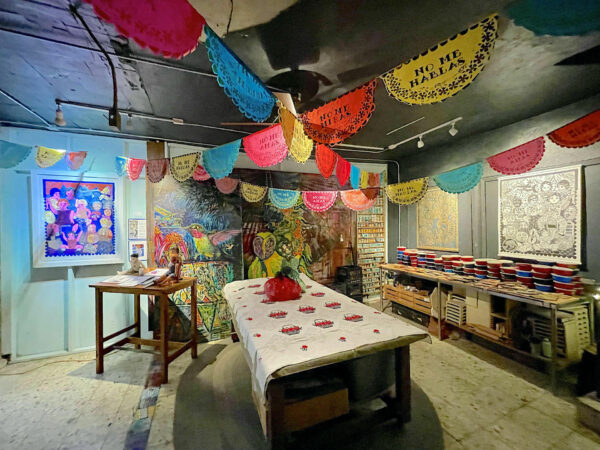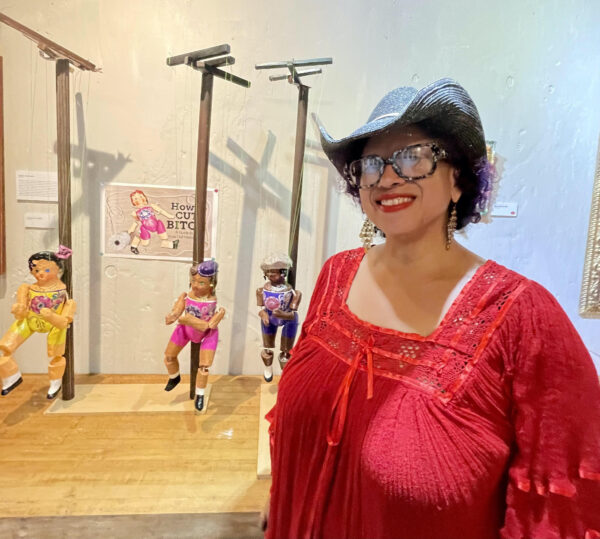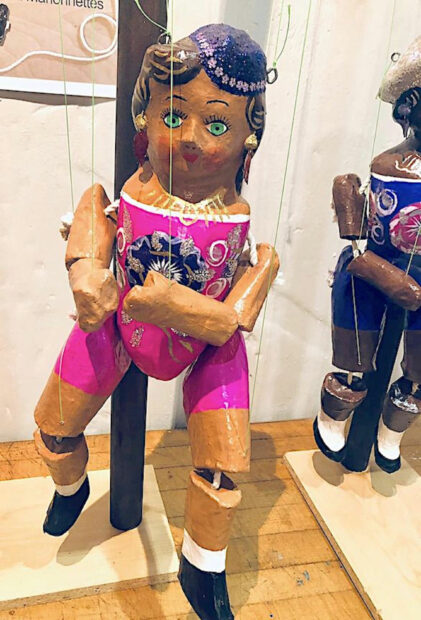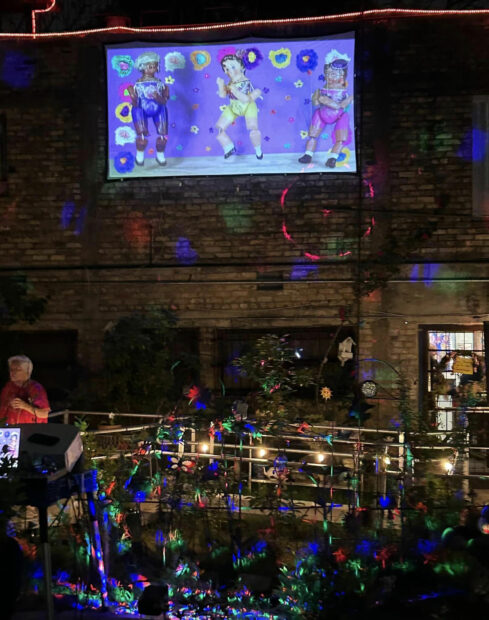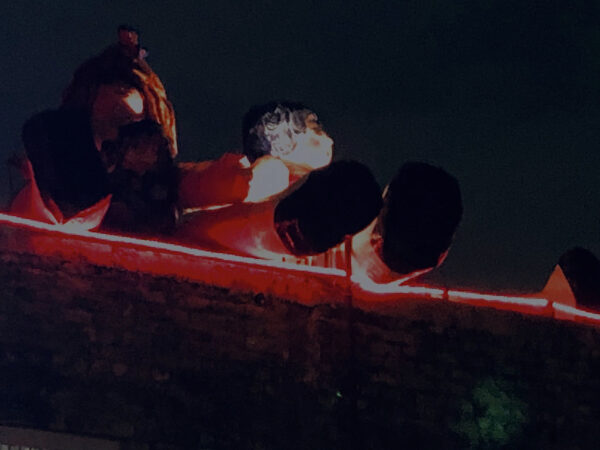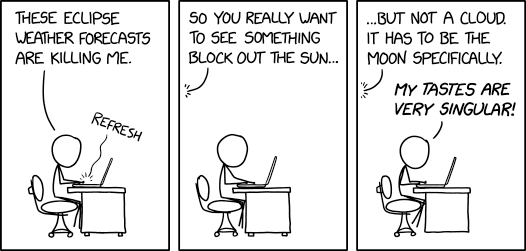Cowboy Who?
Shared posts
A little tutorial about pecs!
Thought it would be great to share it there as well, I hope it can help many here!
The song is Mario no Super Picross Music - Mario Puzzle 2
“Muñecas” Installation Treats Legacy of Prostitution on San Antonio’s Guadalupe Street

Exterior of Elizabeth Rodriguez’s home facing Guadalupe Street, with red lights, faux storefront windows, and giant Lupita dolls. Photo: Ruben C. Cordova.
Artist Elizabeth Rodriguez lives in a strange old building on Guadalupe Street built in 1957 to house Arms Plumbing. According to local lore, confirmed by city records after the event was planned, the building served as a brothel in the 1970s and 80s, when prostitution flourished on this street in the Westside of San Antonio. This tradition was addressed in a multi-media installation/event called Muñecas en La Calle Guadalupe on the evening of March 16, when the building was illuminated with red lights to emphasize its former function.

Exterior of Elizabeth Rodriguez’s home facing Guadalupe Street, with red lights, faux storefront windows, and giant Lupita dolls. Photo: E. A. Davis.
In the post-World War II period, prostitution became deeply entrenched on Guadalupe Street, which had a high concentration of bars. When Rodriguez was in middle school in the late 1970s, students would issue this taunt: “Hey, I saw your mother on Guadalupe street,” implying that the mother in question was there turning tricks. Historically, San Antonio’s red-light districts (a.k.a “Sporting Districts”), including Guadalupe Street, never actually utilized red lights. So, in this work, Rodriguez gave material form to a trope or metaphor. Her prolonged stay in Amsterdam in 1999 had given Rodriguez familiarity with the usage of red lights to signify zones set aside for sex work.
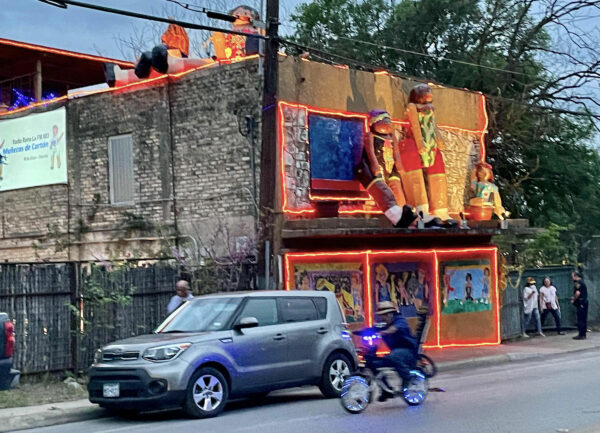
Exterior of Elizabeth Rodriguez’s home facing Guadalupe Street, with red lights, faux storefront windows, and giant Lupita dolls. Photo: Ruben C. Cordova.
Traditional Mexican papier-mâché muñecas (dolls), known as Lupitas, formed the common thread of the installation. According to some local and Mexican traditions, these folkloric objects, when placed in windows in “red-light” districts, served to advertise the profession of prostitution. In this context, they are referred to as “puta” (whore) dolls.
Rodriguez notes, however, that there is no compelling proof that these dolls ever advertised prostitution on Guadalupe Street. Another tradition holds that a woman might buy a Lupita doll, inscribed with the name of her husband’s mistress, in order to inform him that she knew about his affair. Some artists in the exhibition addressed the theme of prostitution in connection with these dolls. Other artists, who grew up playing with these dolls, did not want to associate them with that particular profession.
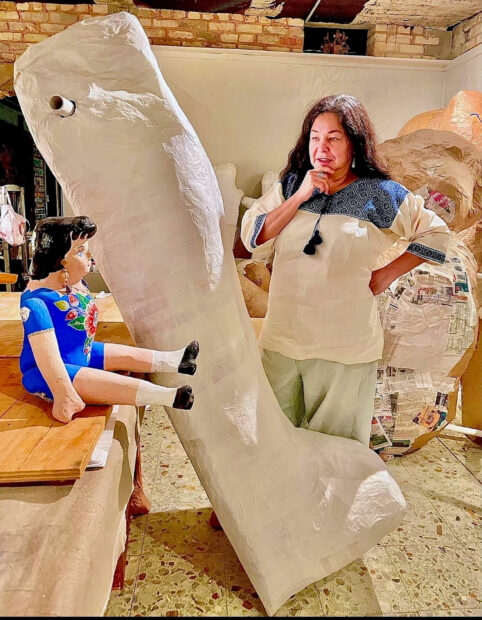
Elizabeth Rodriguez studying the leg of a giant Lupita doll in progress. Photo courtesy of the artist.
Rodriguez and her assistants (which included friends, family, and students) crafted several monumental muñecas over the course of three months. Rodriguez had spent the better part of two years gathering the necessary materials (newspapers, cardboard, chicken wire, plastic bags and other lightweight materials for packing, etc.).

Andy Villareal (center), Elizabeth Rodriguez’s husband, is securing the central muñeca. He also painted the faux windows to create a virtual storefront. The building never had a real opening onto Guadalupe Street, because it served as a garage. The building was accessed from the West, facing Apache Creek. Photo: Barbara Felix.
Several muñecas were placed on the exterior of Rodriguez’s home, in surrealistically inflated homage to their reputed former role on Guadalupe Street.
The largest of these dolls would have been twenty-five feet high had it been able to stand. Rodriguez modeled her dolls on friends, as in the examples pictured above.

Invitation (Marta Sanchez also joined the exhibition after the invitation was printed.) Photo courtesy of the artist.
The Lupita doll served as a common iconography theme utilized by the thirteen women artists that Rodriguez invited to participate in the exhibition, whose work addressed such issues as the (contested) purpose of the traditional dolls, the history of Guadalupe Street as a red-light district, and the general folklore and symbolism of the neighborhood.
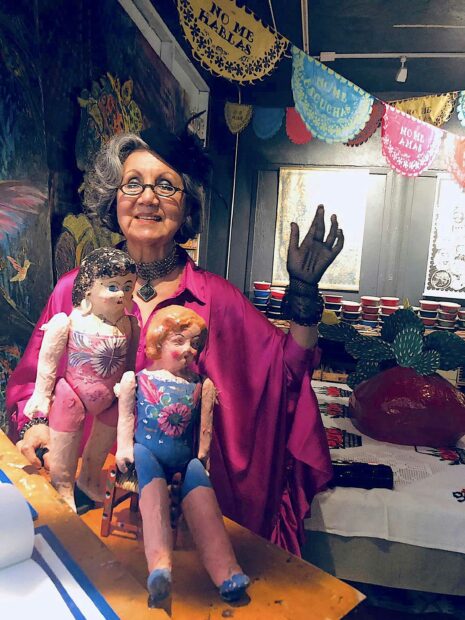
Gloria Sánchez Hart in period dress with two of her Lupita dolls. Her installation is in the background. Photo: Sabra Booth.
Due to the ongoing gentrification of the neighborhood, Rodriguez refers to the exhibition as “an exercise in nostalgia, and a way to say goodbye to the neighborhood,” which is rapidly losing its traditional character. Several artists dressed in period clothing in order to evoke the neighborhood’s earlier days.
The festivities began with Gloria Camarillo Sánchez and the AH Manam Spiritual Circle performing an opening ceremony and indigenous blessing.
They acknowledged the Coahuiltecan people’s claim to the land and they performed the Sacred Four Directions prayer.
The blessing was followed (on the other side of the building) by a fictive radio program reading. It was written by Iñez Saenz, who called it “Reina Radio FM003 – Muñecas de Cartón.”
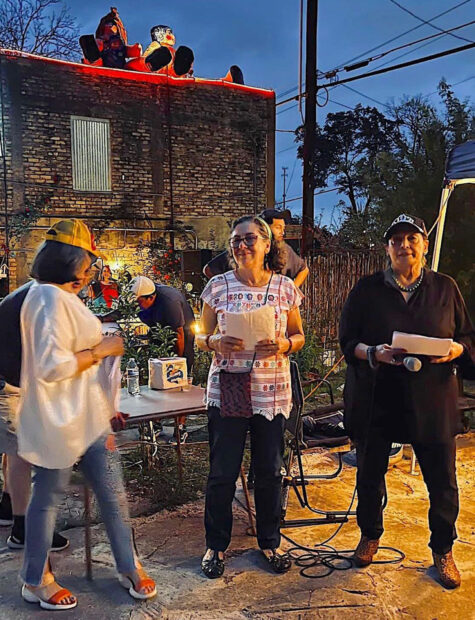
Performance of “Reina Radio FM003 – Muñecas de Cartón,” with Guadalupe Marmolejo, Gladys Cosio-Burger, and Inez Saenz. Photo: Barbara Felix.
Addressing the pre-WWII history of the Lupita dolls, it was performed by Saenz, Gladys Cosio-Burger, and Guadalupe Marmolejo. According to this program, the doll originated as a toy, was transformed into an advertisement for prostitution, and later turned into an accusatory object bought by women who had been cheated on by their spouses.
The exhibition was preceded by many conversations, such as the one above between Veronica Castillo Salas and Elizabeth Rodriguez. Castillo Salas, who is from Pubela, Mexico, maintains that the dolls were never intended as children’s toys. Castillo Salas, who comes from a long line of Mexican artisans, spoke to families in Mexico who created these dolls over generations that confirmed this belief.
In the above painting, Castillo Salas depicts the Lupita dolls as knowing adults, within the context of the Tree of Life.
Edna Lugo and Gloria Sánchez-Hart, on the other hand, according to Rodriguez, view the dolls as toys, not as markers or signs of prostitution or infidelity.
Sánchez-Hart’s installation treats the dolls as toys that she ignored for decades. The papel picado that hangs from the ceiling makes accusatory remarks, as if spoken by the dolls to the artist (translated here from Spanish to English): “you don’t look at me, you don’t listen to me, you don’t talk to me, you don’t love me.”
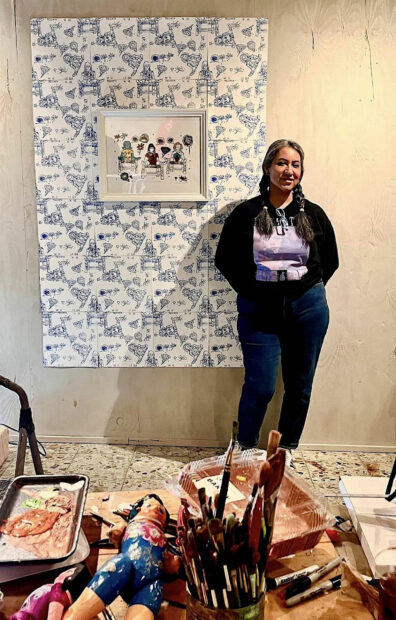
Celeste DeLuna with her “Voices and Seats” installation, framed color reduction print in center (16 x 20 inches), surrounded by fourteen screenprinted panels (12 x 12 inches) on paper in the European toile style. Photo courtesy of the artist.
The central image in the above work derives from a photograph Celeste DeLuna took of a group of Lupita dolls at a Mexican restaurant in Houston. The dolls “struck me as both sexualized and infantilized, much like real life women are treated in regard to their bodies,” she recalls. “As a girl who always loved dolls and stuffed animals, I felt bad for them,” DeLuna added. She describes them as “struck dumb, posed with their legs open… placed on wooden Mexican toy chairs and displayed on a wall at a restaurant.” Importantly, DeLuna points out, “the Lupitas did not have a seat at a table, neither voice nor choice.”
In DeLuna’s view, the dolls are obviously sexualized. She recalls conversations Rodriguez had with women in Mexico, who denied the sexual nature of the Lupita dolls. DeLuna characterized this attitude with the phrase: “lo que se ve, no se habla” (what is seen is not spoken), which is why she uses it as an inscription in this installation.
Since the dolls are working-class folk objects, DeLuna wanted to situate them “in a ‘fancy French doll’ context.” By creating a toile-style wallpaper from the patterns of the dolls in her original print, DeLuna sought to have the dolls “subvert” what she calls “a rarefied atmosphere.” The dolls symbolize working class women, and this is how she pictures “working class women walking in other worlds.”
When Rodriguez invited Kathy Vargas to participate in the exhibition, she brought her a small doll to be photographed. Vargas contributed four hand-colored photographs to the exhibition.
She told me that the dolls in these photographs “are my commentary on how some politicians see women today: sweet, frilly, silent, acquiescent baby factories.”
The photograph illustrated above represents the doll as a “baby factory,” with seventeen offspring. The green color of her outfit and the flower are also symbolic of fertility. In another picture (not illustrated here), the doll is virtually buried under flowers.
In the above photograph, the Lupita doll is incorporated into a frilly doily to such a degree that her corporeal identity is compromised. Through this dematerializing dissolution, the doll takes on the qualities of the doily, implying states of frilliness and passivity.
In Kathy Sosa’s semi-abstract Tree of Life altarpiece, diminutive Lupita dolls have been painted a single, solid color, which drains their vivacity. These dolls represent the many women who lost their lives due to domestic violence.
Barbara Felix utilized dolls to create puppets, which she cut up and carved into puppets that she used for an animation that was projected on the outside of the house.
Felix’s animation was projected on the east exterior wall of the house.
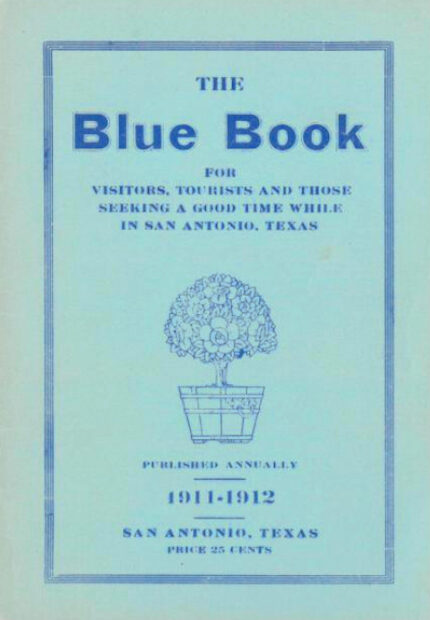
William Keilman, “San Antonio Blue Book,” 1911-12. Photo: Journal of the Life and Culture of San Antonio.
In 1911, William “Billie” Keilman, a former San Antonio policeman who was then a brothel owner, published the San Antonio Blue Book, which he sold for 25 cents. It listed “the names, locations and phone numbers of prostitutes in San Antonio’s red-light district, and it ran advertisements for saloons, restaurants and brothels” (Jennifer Cain, “Bawdy Houses ‘For Those Seeking a Good Time while in San Antonio, Texas’ – The Restrictions and Permissions of Bawdy Houses from 1889-1941,” Journal of the Life and Culture of San Antonio, University of the Incarnate Word).
According to Cain, the “Sporting District” prostitutes were given one of three designations: “A”, “B” or “C.” Whereas most “A” class prostitutes were Anglos in higher-priced brothels, the “C” class prostitutes were mostly Mexican or Black women who worked in establishments that are referred to in the Blue Book as “cribs.” Though white men could patronize all races of prostitutes, Black men were forbidden from consorting with Anglo prostitutes.
Keilman gave the impression that prostitutes were restricted to the “Sporting District” (today’s UTSA downtown campus, near Market Square), which confused early researchers on this topic, who could find no ordinances that placed geographical restrictions on prostitution. It appears that Keilman merely wanted to funnel visitors in the direction of his brothel, which he described in this manner: “In this district you will find the Beauty Saloon conducted by Billie Keilman, a safe and sane thirst parlor” (quoted in Bri Kirkham, “No boundaries? How San Antonio’s red-light district grew,” Texas Public Radio, April 1, 2022).
The U.S. military (which objected to its soldiers contracting venereal diseases) tried to shut down San Antonio’s primary red-light district during World War I. These efforts continued for decades. They were no doubt defeated by the sizable bribes that the operators of these establishments could pay to politicians and the police. Finally, the bawdy houses in the Market Square area were shuttered during World War II. This provided the opportunity for Guadalupe Street to become a prostitution hot spot in subsequent decades.
Bri Glass’ contribution to the exhibition is Blue Zine, which incorporates names and imagery from Keilman’s Blue Book, which Glass scanned at the Texana/Genealogy department of San Antonio’s Central Library.
The Blue Zine is an interactive zine on handmade paper with several illustrations of angels and altarpieces. It serves as “a paper altar to the women in the Blue Book,” some of whom have their names inscribed in it.
This cake, crowned by a large pair of red lips, was a gift to Rodriguez from Raquel Centeno, one of her students.
Night at last drew back its black curtain, and everything vanished, save for the red lights, which, for one evening, illuminated a dark corner of San Antonio’s Westside past.
Muñecas en La Calle Guadalupe, curated by Elizabeth Rodriguez, was on view at 2622 Guadalupe St. on March 16.
The post “Muñecas” Installation Treats Legacy of Prostitution on San Antonio’s Guadalupe Street appeared first on Glasstire.
JooYoung Choi Among Artists Acquired by the Dallas Museum of Art from the Dallas Art Fair
The Dallas Art Fair (DAF) and the Dallas Museum of Art (DMA) have announced the museum’s acquisition of three works of art created by women artists, including a piece from Inman Gallery by Houston-based JooYoung Choi.
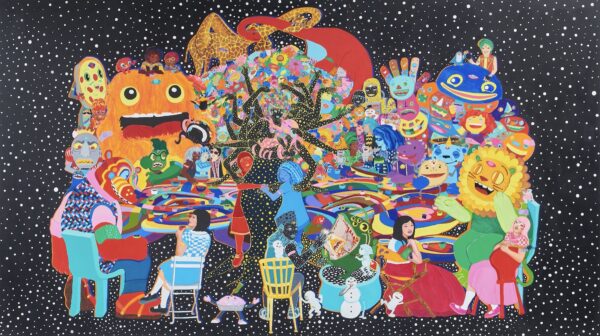
JooYoung Choi, “The Table of Love,” 2022, acrylic, gouache, vinyl paint, carbon transfer, Gelli print, airbrush, Duralar, cut paper on canvas, 69.25 x 123 inches. Acquired from Inman Gallery
Each year, since its establishment in 2016, the Dallas Art Fair Foundation Acquisition Program has supported the acquisition of contemporary works from the fair for the museum’s permanent collection. Over the last eight years, the program has funded $875,000 worth of acquisitions to the DMA, including this year’s grant of $100,000. Although the grant amount was the same last year, the fund supported the purchase of 12 artworks. This year the museum took a different approach, acquiring works that are much larger in scale than previous years.

Ailbhe Ní Bhriain, “Interval I”, 2023, jacquard tapestry, cotton, wool, silk, Lurex, 116.1 x 155.9 inches. Courtesy the artist and Kerlin Gallery.
During a press preview at DAF, Dr. Anna Katherine Brodbeck, the DMA’s Hoffman Family Senior Curator of Contemporary Art, said, “This year’s acquisitions are some of the most ambitious acquired through the fund to date. Collectively, they speak to the role the artists play as world builders, and will allow the DMA to speak to our audiences about the contemporary moment with all the beauty and complexity of their intricate work.”

Thania Petersen, “SJAMBOKLAND,” 2022, embroidery thread on cotton poplin, Japanese glass cut beads, 61.50 x 105 inches. Acquired from Nicodim Gallery
The other artists that were selected are Ailbhe Ní Bhriain, an Irish artist working in film, computer generated imagery, collage, tapestry, print, and installation, (acquired from Kerlin Gallery) and Thania Petersen, a South African artist whose multidisciplinary approach includes photography, performance, and installation (acquired from Nicodim Gallery). The works were selected earlier in the week by the members of the DMA’s curatorial team, including Ms. Brodbeck; Dr. Vivian Li, the Lupe Murchison Curator of Contemporary Art; Ade Omotosho, the Nancy and Tim and Hanley Assistant Curator of Contemporary Art; and Agustín Arteaga, the DMA’s Eugene McDermott Director; along with a group of fund donors.
The 2024 fund donors are Jim Blake, Aleka Calsoyas, Sheryl and Geoff Green, Kristi Kirkpatrick, Marlo and Jeffrey Melucci, Cliff Risman, Linda and David Rogers, Gowri and Alex Sharma, Marlene and John Sughrue, and Teresa Tsai.
The post JooYoung Choi Among Artists Acquired by the Dallas Museum of Art from the Dallas Art Fair appeared first on Glasstire.
I’m the Draft List at This Brewery and No, You Can’t Have a Light Beer
Hey man, welcome to our brewery. I’m gonna be your draft list today. The first thing you should know about me is this: I’m approachable. I believe beer is for everyone. If that means I’m a draft list without a single beer that tastes like beer, then hell yeah, brother—that’s what it’s all about.
You seem like the type of guy who’s lookin’ to sip on a couple of easy-drinking light brews with the fellas. I bet you even wanna be able to stand up and walk in a straight line when you head out of here. Counter pitch: maybe you don’t?
Listen, I pride myself on my impressive and diverse range of beers, but every single one has an ABV of 7.5 percent or higher. No matter what beer you choose, you better buckle up, my man, because you’re about to black out before the sun sets.
First thing you’re gonna wanna do is check out my super crushable IPAs. I’m talkin’ Double, Triple, Quadruple, Quintuple. West Coast, East Coast, Midwest, Milkshake. Juicy, Hazy, Hazier, Hozier. You name it, I’ve got it. And not just one. I’ve got like three kinds of each of those. This might have you thinking, “Cool, I like a hoppy beer. I understand what these IPAs have to offer.” Here’s the thing: no, you don’t.
Sure, we made a “normal” IPA once. But then we were like, why make a beer that’s enjoyable to drink when we could make a beer that’s not? So now we’re brewin’ with the craziest shit, dude, for real. I’m talkin’ ice cream sandwiches, In-N-Out cheeseburgers, grandma’s rigatoni. If it sounds like a mistake, we’re brewin’ it and we’re callin’ it something like, “I Bet You’ve Never Seen a Penguin Drive a Sportscar.”
If that’s not your vibe, that’s totally cool, because I bet you’ll love our sours. Check it out—we have seventeen different sours, and all of them taste like we milked a Trolli gummy worm. That’s right, we brewed them with lactose. If that’s not enough to get you goin’, I’ve got one word for you: thick. We’re gonna pour you this beer, and you’re gonna think it’s a smoothie. You’re gonna drink it, and you’re still gonna think it’s a smoothie. But it’s not. It’s a beer, technically. It’s 17 percent.
No worries if you’re feelin’ a little less adventurous today, man. I’ve also got twelve different flavored seltzers, three pale ales that all taste like IPAs, and a stout so strong that we’re legally obligated to watch you drink it.
Lastly, I’ve got one lager. It’s super good, suuuper drinkable. It’s the type of lager you crack open on the first warm day of the year, you know what I mean? Imagine this: You’re drinkin’ it out on the patio. The sun is softly shining on your face. It tastes so simple and so awesome, you’re like, “Dude, why don’t people make more beers like this?” but you don’t look into it because you’re busy drinkin’ a beer on the patio, and it’s frickin’ sweet. Unfortunately, I am outta that one right now.
What’s that? A pilsner? Ha ha. Good one. I think what you’re looking for is something we here like to call a “drinkable liquid.” The closest thing we have to that is gonna be a cup of room-temperature water from the tap over there, okay? Awesome. Cheers, brother.
A Roadmap to Rebuilding Communities
When we think of what our communities need, we usually think of affordable homes, good schools, and grocery stores. Not wide towering highways. Yet, in the past 70-some years, highways have dictated community development in urban centers. They’ve torn through low-income communities of color, displacing families, homes, and businesses. As a result, people move farther away; we languish in traffic, get home from work later, and spend less time with our family. We’ve accepted growing air pollution as the inevitable cost of the lives we’ve built around our cars and the neighborhoods we’ve built around highways. For many of us, we’ve never seen or imagined an alternative.
But in her new book City Limits: Infrastructure, Inequality, and the Future of America’s Highways, Megan Kimble, a journalist covering transportation and housing (and former Texas Observer editor), tells Texans: It wasn’t always this way, nor does it have to be. By interweaving the history of the interstate highway system with stories from past and present community members of Houston’s Fifth Ward, East Austin, and Dallas’ Deep Ellum, Kimble shows that these urban neighborhoods were not always designed around never-ending highway expansion. And by spotlighting the current struggles of activists resisting the Texas Department of Transportation’s (TxDOT) efforts to widen highways there, the author reimagines our cities’ futures.

City Limits reveals the human consequences of our built environment. One character, O’Nari Burleson, was born and raised in Houston’s historically Black Fifth Ward before I-10 tore her community apart in the mid-1960s. Burleson describes a place where everyone knew everyone, where she walked only a few minutes to school and found everything she needed at thriving local businesses.
Racism underlay highway development. After the Federal Highway Act authorized a 40,000-mile national system of interstate highways in 1944, Alfred Johnson, executive director of the lobby group American Association of State Highway Officials, said, “Some city officials expressed the view in the mid-1950s that the urban Interstates would give them a good opportunity to get rid of the local ‘n—rtown.’” The highways facilitated white flight from urban centers to suburban neighborhoods with racially restrictive covenants, while Black and Hispanic neighborhoods were redlined to deny families federally backed loans.
By the time I-10 was opened in 1966, 1,220 structures were erased from the Fifth Ward, including 11 churches, five schools, and two hospitals. O’Nari started relying on car transport to get to school. Seven-hundred families left the neighborhood at this time. “When I grew up, it was just people everywhere. This used to be full of people, full to the brim,” Burleson says. But the “neighborhood grew quieter, streets emptier.”
As in the Fifth Ward, the interstate highway came for Black communities in East Austin and Dallas’ Deep Ellum, neighborhoods that Freedmen had created to escape racism. These communities were cultural and commercial centers for Black people in Texas, but the state and federal transportation agencies only saw “blight” there. In 1950, the Interregional Highway, or I-35, was built, segregating Austin along racial lines. Over the next two decades, more than half a million homes along its east-side corridor would be displaced. In 1955, the Central Expressway tore through Deep Ellum, razing 54 city blocks.
“We do not believe that the Interstate System is the vehicle for solving rush-hour traffic problems, or for local bottlenecks. … Rapid transit and mass transit systems are the solution.”
The history of the interstate highway system that Kimble unspools is a history of accumulated racist policies, flawed planning, and missed opportunities to make amends.
In 1956, President Eisenhower signed the Interstate Highway Act, committing $25 billion to build 41,000 miles of interstate highways across the country over 13 years. The act created the Highway Trust Fund, diverting all taxes on gas and motor vehicles to interstate construction. What was left up for debate was whether the money should be used to connect cities—thus routing interstate traffic around urban areas—or to alleviate congestion within urban areas, routing the interstate through cities.
General John S. Bragdon, tasked by Eisenhower with investigating the alternatives, wrote, “We do not believe that the Interstate System is the vehicle for solving rush-hour traffic problems, or for local bottlenecks. … Rapid transit and mass transit systems are the solution.”
Bragdon added that communities should not be solely developed around transportation needs: “The highway plan should not be the central pattern around which a community develops. … The basic plan for all community development should be an economic growth and land use plan.” Even though Eisenhower agreed, Bragdon’s report never saw the light of day. Seeking reelection, Eisenhower buried the report to prevent blowback from local leaders eager to build more highways in their cities.
Early on, Bragdon and transportation engineers noted the phenomenon of induced demand—meaning that when bigger roads are built, traffic increases to fill those roads, in turn reducing space for public transit. Yet successive federal and state transportation policies have only fueled this vicious cycle, committing money to highways over public transit at the behest of oil and auto industry lobbyists.
In 2022, Texas Governor Greg Abbott approved the Unified Transportation Plan, an $85 billion, 10-year plan with 96 percent of its funding allocated to highway construction. State law requires TxDOT to use at least 97 percent of its funding for roads. As a result, Texas cities rely more on the federal government than the state for public transit funding, even though the federal Highway Trust Fund gives only 20 percent to public transportation. In 2021, President Joe Biden’s $2.3 billion infrastructure act committed only a fraction of transportation funds to public transit while highways received a 90 percent increase in funding.
Instead of righting past wrongs, Kimble reveals that TxDOT is now doubling down on racist highway policies, demanding more homes, schools, and businesses be destroyed in the same affected communities to add more lanes to the highways. Without considering alternative plans or modes of transportation, TxDOT recites its slogan that traffic will be unsustainable otherwise.
Many residents aren’t buying what the state agency is selling. Kimble follows community activists at door-knocking activities, protests, and numerous TxDOT hearings as they struggle to save their neighborhoods. In Houston, activists with Stop TxDOT I-45 won an agreement to address concerns around the loss of affordable housing and increase in air pollution. In Austin, members of Rethink35 are organizing to stop the expansion of I-35, and in Dallas, activists want to tear down I-345 and revitalize 245 acres of wasted land around the highway. These communities are linking up with a national movement of urban communities that want to demolish unwanted highways and use the land to build affordable housing, parks, schools, and local businesses—to serve people, not cars.
Kimble concludes City Limits by highlighting the hopeful spirit of so many fighting to rebuild their communities. It’s an uphill battle challenging TxDOT, but they have no choice: “It’s our home,” a STOP TxDOT I-45 activist says. Kimble writes, “Like a suture over a scar … harm cannot be undone, it can only be repaired.”
After all, there’s only so far people can move, only so much land we can allow TxDOT to take, and only so many hours in a day we can sit in traffic.
The post A Roadmap to Rebuilding Communities appeared first on The Texas Observer.
‘TxDOT’s Still Bulldozing Over Our Communities’
Fifth Ward resident Kendra London, 43, helped form the neighborhood organization Our Afrikan Family to serve and educate her community about a major threat: an expansion of Interstate 45 that will wipe out hundreds of Houston homes and businesses and has already forced evictions. For the past five years, she and other advocates have been door-knocking and holding meetings to educate residents about TxDOT’s plans. A little over a year ago, she thought they had made progress when the Federal Highway Administration signed a Voluntary Resolution Agreement with TxDOT ending a two-year civil rights investigation into the discriminatory environmental and economic impact the North Houston Highway Improvement Plan would have on several Black and brown neighborhoods.
The agreement allowed the project, a $9.7 billion plan to widen Interstate 45 and overhaul the downtown freeway system, to proceed. TxDOT expects construction to continue until 2042. In return, TxDOT agreed to mitigate the impacts on communities of color by considering ways to reduce the project’s footprint, monitoring air quality, providing more transparency, and helping residents, businesses, and organizations relocate within the community.
But TxDOT appears to be breaking its promises, according to documents and interviews with London and other community organizations.

TxDOT continues to demolish more public housing units than it was approved to displace, records show. Experts say its promise for pollution monitoring, which so far has included a report from a single monitor, is inadequate. And even TxDOT’s own reports show that promises to help businesses have fallen short. By September, TxDOT had to complete a survey of an estimated 300 affected non-residential businesses and organizations and document progress in providing relocation services. But TxDOT surveyed only 21 so-called “non-residential units” and claimed none needed relocation services.
Many residents told the Texas Observer they don’t know what will happen to them even though construction will begin as soon as August 1. TxDOT will “just pick people up and just move them out, while people are still in the dark and don’t know what’s happening,” London said. “TxDOT’s still bulldozing over our communities.”
TxDOT restated provisions from the agreement in response to an email the Observer sent outlining complaints from the community.
A civil rights complaint filed in December 2021 by five advocacy organizations calculated that 160 single-family homes, 433 multi-family units, 486 public housing and low-income units, 344 businesses, five places of worship, and at least 2 schools would be displaced. The resolution agreement fell short of community demands to reduce the numbers of those displaced, though it requires TxDOT to provide relocation services for affected businesses and residents to ensure they are “not cut out from the community” and to publicly post information to facilitate relocation.
“It’s obvious decisions have already been made. They never follow up on our questions.”
Julia Orduña, regional director at the low-income housing advocacy organization Texas Housers, like London, expressed concern that more public housing residents are being displaced than necessary and many have received inadequate assistance.
While all right-of-way acquisitions and demolition for the project were supposed to cease during the federal government’s two-year investigation, the Houston Housing Authority proceeded to evict all residents still living in 184 units of the public housing complex Clayton Homes, which was then demolished. London said the agency hired only a few “navigators” to advise residents on “enhanced relocation services” and many residents never received help.
TxDOT originally stated it plans to acquire only two of the six buildings of the public housing complex Kelly Village, but in its September progress report and December public presentations the agency revealed a new map showing the footprint encompasses all six buildings housing 270 units. When questioned about this, TxDOT public information officer Danny Perez wrote: “TxDOT is working with the Houston Housing Authority to acquire 50 of the 270 Kelly Village public housing units.” Furthermore, it’s unclear whether the hundreds of displaced public housing residents will be able to relocate to affordable units within the community. TxDOT has promised displaced public housing residents first rights to affordable housing in two new mixed-income residential units planned within two miles of Clayton Homes. But residents have not been told how many affordable units will be available, what income level will be used by developers to determine eligibility, and how long these units will remain affordable,” Orduña said.
“There is no real accountability with private entities managing these low-income units. So is there actual security for households to even be able to move there, and then when they do, [to] not fear displacement again?” Orduña said.
The resolution agreement also required TxDOT to inform property owners of an “occupancy agreement” option to remain at the property until the start of construction. But, as of September last year, TxDOT reported they had entered into only nine occupancy agreements and only three were active.
Community organizers, like Stop TxDOT I-45 organizer Alexandra Smither, also question the amount of outreach TxDOT has done with property owners and say that private right-of-way acquisition companies have long been pressuring homeowners to sell below market value before the project even received final approval.
Low-income renters, living in the 400-some multi-family units in the project’s footprint, are even more out of luck than homeowners, businesses, or public housing residents because they are at the whims of their landlord’s decision to sell their property. However, under the resolution agreement, renters were deemed eligible for the $30 million set aside for affordable housing initiatives and relocation compensation. Within three months of signing its agreement with the feds, TxDOT was required to gather public input and publicize a plan for how they would use this pot of money.
According to the resolution agreement, TxDOT agreed to hold public meetings twice a year in “an open forum for the community to provide feedback, raise issues, and ask questions about TxDOT’s compliance with the agreement.” Meetings were required to be accessible to residents who are disabled and who have limited English proficiency.
But attendees at the first public meeting TxDOT held last December reported that agency representatives didn’t leave enough time for community feedback, foreign language translation to English didn’t last the entire meeting, and the room was too small and crowded to accommodate disabled residents. Many residents got frustrated and left.
“TxDOT is not listening. It’s obvious decisions have already been made. They never follow up on our questions,” London said.
In a city ranked the sixth-worst for fine particle air pollution, civil rights complainants had noted that TxDOT’s overhaul of the downtown freeway interchanges would shift more traffic and vehicular air pollution toward the low-income communities of color who already face higher rates of asthma and cancer—in Near Northside, Fifth Ward, and Second Ward, away from the whiter, wealthier communities of Memorial Park, Fourth Ward, and Midtown.
The resolution agreement failed to force TxDOT to mitigate past environmental harms when the agency built Houston’s main highways through redlined Black and brown communities. It only required TxDOT to install one air monitor in each of the three segments of the project totaling 24 miles. In order to establish a baseline reading of pollutant levels, TxDOT must monitor the air for one year before starting construction in that segment. In response, TxDOT deployed one air monitor at the southernmost tip of Segment 3, a 12.3 mile area including the downtown interchanges.
So far, the agency has shared only one report from a month-long reading of the Segment 3 air monitor with the public.
“It’s not enough,” said Anthony D’Souza, research and policy coordinator for Air Alliance Houston. “Any expert can tell you that one monitor [per segment] is not enough to determine pollution levels, especially for a project that expansive.”
D’Souza said that average readings over a day or three days water down the data and are insufficient to understand what pollution levels are like during peak traffic hours.
Yet even that limited data shows that before construction, nitrous oxide levels exceed EPA standards, he said. Other common vehicular pollutants, like ozone, are not being measured at all. After a few hours, these chemicals cause throat irritation, coughing and wheezing and over longer periods can lead to asthma, heart disease, lung disease, cognitive impairment, and cancer.
“You end up underestimating the levels of pollution caused by the traffic on the freeway, and it leads you to believe that the project won’t have a substantial impact on pollution levels,” D’Souza said.
The proposed expansion project will add four more lanes, two each way to I-45 and another four lanes to a segment of I-10. For years, community members have called on the agency to reduce the number of lanes it plans to build.
The resolution agreement calls for TxDOT to “evaluate reasonable opportunities to reduce the project footprint” but doesn’t specify how. To date, community members and organizations have not received any information about how TxDOT plans to reduce the footprint of the plan.
“At the December federally required meetings, TxDOT employees were hesitant to talk about reducing the footprint, and it certainly was not suggested. The federal government needs to ensure it truly happens,” said Smither.
Community members are organizing to call on the feds to step in and enforce the agreement. The Federal Highway Authority has a lot of power. If it finds TxDOT in violation of its agreement, it can ask the state agency to remedy its actions, pursue sanctions, withhold federal highway funds, and ask the Department of Justice to enforce the agreement.
“We are begging the federal government to step in and live up to their big promises of protecting people from further damage wrought by highway expansion. They have the power. They need to use it. What’s happening here is wrong,” Smither said.
In the mid-1960s, as construction of Houston’s Interstate 10 razed swaths of the predominantly Black Fifth Ward community, London’s grandmother came home one day to find another house had been dropped into her backyard.
“There was no communication or community involvement then. And there’s no communication or community involvement now,” London said.
The post ‘TxDOT’s Still Bulldozing Over Our Communities’ appeared first on The Texas Observer.
Emails from My Dentist That Would Actually Make Me Schedule an Appointment
YOU’RE OVERDUE FOR A CLEANING! Jennifer at reception started having an affair with one of the dentists, and her husband will be storming into the office to confront them about it during your appointment.
YOU’RE OVERDUE FOR A CLEANING! Our new latex gloves are churro-flavored.
YOU’RE OVERDUE FOR A CLEANING! We are going to start publicly posting on our website when all of our patients’ last appointments were, so you can’t lie when your mom asks. HIPAA be damned.
YOU’RE OVERDUE FOR A CLEANING! The TV in our waiting room is playing Erin Brockovich.
YOU’RE OVERDUE FOR A CLEANING! I really shouldn’t be telling you this, but did you know that Jonathan Groff is one of our patients, too? Who knows, maybe you might bump into him here.
YOU’RE OVERDUE FOR A CLEANING! Your teeth look disgusting when you wear a white shirt. Everybody thinks so.
YOU’RE OVERDUE FOR A CLEANING! We promise we won’t annoy you about getting your wisdom teeth removed this time. And won’t even ask you how often you floss. That’s none of our business.
YOU’RE OVERDUE FOR A CLEANING! We’ll let you take a silly one on the X-ray.
YOU’RE OVERDUE FOR A CLEANING! One time, somebody put off their cleaning for an extra month, and all of their teeth fell out, and they died. I’m sure that won’t happen to you though… but you never know.
YOU’RE OVERDUE FOR A CLEANING! There’s a bounce house in the parking lot now.
YOU’RE OVERDUE FOR A CLEANING! Honestly, forget about posting it to our website. How about we call your mom directly and tell her when you last came in? We have her phone number since she’s your emergency contact. Guess that means you’re probably single, huh? Maybe you wouldn’t be if you had a better smile… just saying.
YOU’RE OVERDUE FOR A CLEANING! We taught the fish in the lobby’s aquarium how to do a loop-the-loop—you gotta come check this out.
YOU’RE OVERDUE FOR A CLEANING! Help! We’re trapped under something heavy and need you to come free us. We’re only able to reach our keyboard to send this one email, and the battery is about to die, so you’re our only hope.
YOU’RE OVERDUE FOR A CLEANING! In the mood to have a boob graze your ear? Come on down!
Pluralistic: Too big to care (04 Apr 2024)
Today's links
- Too big to care: Enshittification is a choice.
- Hey look at this: Delights to delectate.
- This day in history: 2009, 2014, 2019, 2023
- Upcoming appearances: Where to find me.
- Recent appearances: Where I've been.
- Latest books: You keep readin' em, I'll keep writin' 'em.
- Upcoming books: Like I said, I'll keep writin' 'em.
- Colophon: All the rest.
Too big to care (permalink)
Remember the first time you used Google search? It was like magic. After years of progressively worsening search quality from Altavista and Yahoo, Google was literally stunning, a gateway to the very best things on the internet.
Today, Google has a 90% search market-share. They got it the hard way: they cheated. Google spends tens of billions of dollars on payola in order to ensure that they are the default search engine behind every search box you encounter on every device, every service and every website:
https://pluralistic.net/2023/10/03/not-feeling-lucky/#fundamental-laws-of-economics
Not coincidentally, Google's search is getting progressively, monotonically worse. It is a cesspool of botshit, spam, scams, and nonsense. Important resources that I never bothered to bookmark because I could find them with a quick Google search no longer show up in the first ten screens of results:
https://pluralistic.net/2024/02/21/im-feeling-unlucky/#not-up-to-the-task
Even after all that payola, Google is still absurdly profitable. They have so much money, they were able to do a $80 billion stock buyback. Just a few months later, Google fired 12,000 skilled technical workers. Essentially, Google is saying that they don't need to spend money on quality, because we're all locked into using Google search. It's cheaper to buy the default search box everywhere in the world than it is to make a product that is so good that even if we tried another search engine, we'd still prefer Google.
This is enshittification. Google is shifting value away from end users (searchers) and business customers (advertisers, publishers and merchants) to itself:
https://pluralistic.net/2024/03/05/the-map-is-not-the-territory/#apor-locksmith
And here's the thing: there are search engines out there that are so good that if you just try them, you'll get that same feeling you got the first time you tried Google.
When I was in Tucson last month on my book-tour for my new novel The Bezzle, I crashed with my pals Patrick and Teresa Nielsen Hayden. I've know them since I was a teenager (Patrick is my editor).
We were sitting in his living room on our laptops – just like old times! – and Patrick asked me if I'd tried Kagi, a new search-engine.
Teresa chimed in, extolling the advanced search features, the "lenses" that surfaced specific kinds of resources on the web.
I hadn't even heard of Kagi, but the Nielsen Haydens are among the most effective researchers I know – both in their professional editorial lives and in their many obsessive hobbies. If it was good enough for them…
I tried it. It was magic.
No, seriously. All those things Google couldn't find anymore? Top of the search pile. Queries that generated pages of spam in Google results? Fucking pristine on Kagi – the right answers, over and over again.
That was before I started playing with Kagi's lenses and other bells and whistles, which elevated the search experience from "magic" to sorcerous.
The catch is that Kagi costs money – after 100 queries, they want you to cough up $10/month ($14 for a couple or $20 for a family with up to six accounts, and some kid-specific features):
https://kagi.com/settings?p=billing_plan&plan=family
I immediately bought a family plan. I've been using it for a month. I've basically stopped using Google search altogether.
Kagi just let me get a lot more done, and I assumed that they were some kind of wildly capitalized startup that was running their own crawl and and their own data-centers. But this morning, I read Jason Koebler's 404 Media report on his own experiences using it:
https://www.404media.co/friendship-ended-with-google-now-kagi-is-my-best-friend/
Koebler's piece contained a key detail that I'd somehow missed:
When you search on Kagi, the service makes a series of “anonymized API calls to traditional search indexes like Google, Yandex, Mojeek, and Brave,” as well as a handful of other specialized search engines, Wikimedia Commons, Flickr, etc. Kagi then combines this with its own web index and news index (for news searches) to build the results pages that you see. So, essentially, you are getting some mix of Google search results combined with results from other indexes.
In other words: Kagi is a heavily customized, anonymized front-end to Google.
The implications of this are stunning. It means that Google's enshittified search-results are a choice. Those ad-strewn, sub-Altavista, spam-drowned search pages are a feature, not a bug. Google prefers those results to Kagi, because Google makes more money out of shit than they would out of delivering a good product:
No wonder Google spends a whole-ass Twitter every year to make sure you never try a rival search engine. Bottom line: they ran the numbers and figured out their most profitable course of action is to enshittify their flagship product and bribe their "competitors" like Apple and Samsung so that you never try another search engine and have another one of those magic moments that sent all those Jeeves-askin' Yahooers to Google a quarter-century ago.
One of my favorite TV comedy bits is Lily Tomlin as Ernestine the AT&T operator; Tomlin would do these pitches for the Bell System and end every ad with "We don't care. We don't have to. We're the phone company":
https://snltranscripts.jt.org/76/76aphonecompany.phtml
Speaking of TV comedy: this week saw FTC chair Lina Khan appear on The Daily Show with Jon Stewart. It was amazing:
https://www.youtube.com/watch?v=oaDTiWaYfcM
The coverage of Khan's appearance has focused on Stewart's revelation that when he was doing a show on Apple TV, the company prohibited him from interviewing her (presumably because of her hostility to tech monopolies):
https://www.thebignewsletter.com/p/apple-got-caught-censoring-its-own
But for me, the big moment came when Khan described tech monopolists as "too big to care."
What a phrase!
Since the subprime crisis, we're all familiar with businesses being "too big to fail" and "too big to jail." But "too big to care?" Oof, that got me right in the feels.
Because that's what it feels like to use enshittified Google. That's what it feels like to discover that Kagi – the good search engine – is mostly Google with the weights adjusted to serve users, not shareholders.
Google used to care. They cared because they were worried about competitors and regulators. They cared because their workers made them care:
https://www.vox.com/future-perfect/2019/4/4/18295933/google-cancels-ai-ethics-board
Google doesn't care anymore. They don't have to. They're the search company.
Hey look at this (permalink)

- The Retraction Watch Mass Resignations List https://retractionwatch.com/the-retraction-watch-mass-resignations-list/ (h/t Gregory Charlin)
-
I am the Comic / Comic Book Walk https://www.kickstarter.com/projects/cecilseaskull/i-am-the-comic-comic-book-walk
-
Capitalists Hate Capitalism https://locusmag.com/2024/03/cory-doctorow-capitalists-hate-capitalism/
This day in history (permalink)
#15yrsago Why URL shorteners suck https://joshua.schachter.org/2009/04/on-url-shorteners
#15yrsago Game industry exec celebrates 60+ hour work-weeks https://web.archive.org/web/20090405131359/playthisthing.com/mothers-dont-let-your-children-grow-be-game-developers
#15yrsago Nine year old’s survey project excluded from school because he learned some people don’t think of themselves as male or female https://thefourthvine.livejournal.com/102417.html
#15yrsago Help save Bruce Sterling and Jasmina Tesanovic from US immigration hell! https://web.archive.org/web/20090405213303/http://blog.wired.com/sterling/2009/04/bruce-sterling.html
#15yrsago Pneumatic tube-based systems — the real series of tubes https://www.youtube.com/watch?v=MvSeL_LfdbA
#15yrsago Berlusconi declares war on the press https://www.repubblica.it/2009/04/sezioni/esteri/nato-strasburgo/calunnia-tv/calunnia-tv.html
#10yrsago Private equity, an infection that is eating the world https://web.archive.org/web/20140330004925/https://www.ericgarland.co/2014/03/29/parasite-economy/
#10yrsago UK Tories call for a national of slaves https://www.antipope.org/charlie/blog-static/2014/04/a-nation-of-slaves.html
#10yrsago Daniel Ellsberg to keynote HOPE X in NYC this summer https://www.2600.com/content/daniel-ellsberg-keynote-hope-x
#10yrsago Yahoo beefs up security in two meaningful and important ways https://www.eff.org/deeplinks/2014/04/yahoo-protects-users-lots-more-encryption
#10yrsago The Gettysburg Address: A Graphic Adaptation, a nuanced and moving history of race, slavery and the Civil War https://memex.craphound.com/2014/04/04/the-gettysburg-address-a-graphic-adaptation-a-nuanced-and-moving-history-of-race-slavery-and-the-civil-war/
#10yrsago Britain is turning into a country that can’t tell its terrorists from its journalists https://memex.craphound.com/2014/04/03/britain-is-turning-into-a-country-that-cant-tell-its-terrorists-from-its-journalists/
#10yrsago Stop-and-frisk as the most visible element of deep, violent official American racism https://www.theatlantic.com/national/archive/2014/04/what-i-learned-about-stop-and-frisk-from-watching-my-black-son/359962/
#10yrsago David “Debt” Graeber evicted, implicates NYPD intelligence, claims revenge-harassment for OWS participation http://nielsenhayden.com/makinglight/archives/015820.html
#10yrsago Open net gets a huge boost in the EU: net neutrality and no roaming fees https://web.archive.org/web/20140405234420/http://www.marietjeschaake.eu/2014/04/mep-european-parliament-supports-proposal-schaake-to-enshrine-net-neutrality-in-european-law/
#10yrsago Cats of Tanglewood Forest: illustrated modern folktale from Charles de Lint and Charles Vess https://memex.craphound.com/2014/04/03/cats-of-tanglewood-forest-illustrated-modern-folktale-from-charles-de-lint-and-charles-vess/
#10yrsago House Science Committee: a parliament of Creationists, Climate Deniers (and dunces) https://www.scientificamerican.com/blog/the-curious-wavefunction/the-house-of-representatives-committee-on-science-is-turning-into-a-national-embarrassment/
#10yrsago Big Data has big problems https://www.ft.com/content/21a6e7d8-b479-11e3-a09a-00144feabdc0
#5yrsago 540 million Facebook users’ data exposed by third party developers https://www.upguard.com/breaches/facebook-user-data-leak
#5yrsago Elizabeth Warren proposes holding execs criminally liable for scams and data breaches https://www.washingtonpost.com/opinions/elizabeth-warren-its-time-to-scare-corporate-america-straight/2019/04/02/ca464ab0-5559-11e9-8ef3-fbd41a2ce4d5_story.html
#5yrsago How EFF’s Eva Galperin plans to destroy the stalkerware industry https://www.wired.com/story/eva-galperin-stalkerware-kaspersky-antivirus/
#5yrsago After years of insisting that DRM in HTML wouldn’t block open source implementations, Google says it won’t support open source implementations https://memex.craphound.com/2019/04/03/after-years-of-insisting-that-drm-in-html-wouldnt-block-open-source-implementations-google-says-it-wont-support-open-source-implementations/
#5yrsago After months of insisting that #Article13 doesn’t require filters, top EU Commissioner says “Article 13 requires filters” https://memex.craphound.com/2019/04/03/after-months-of-insisting-that-article13-doesnt-require-filters-top-eu-commissioner-says-article-13-requires-filters/
#5yrsago Notices at Intel press event seem to say attending photographers must assign copyright to all pictures and videos to the company? https://web.archive.org/web/20200616222543/http://mitchwagner.com/2019/04/02/video-consent-notice-posted-discreetly-in-a-couple-of-places-on-the-walls-at-the-intel-press-analyst-event-today/
#5yrsago Patagonia tells banks and oil companies that they can no longer buy co-branded vests https://www.buzzfeednews.com/article/katienotopoulos/patagonia-power-vest-policy-change
#5yrsago Talking about Radicalized with the CBC: Privilege, atavism, techno-realism and seizing the means of information https://www.cbc.ca/books/cory-doctorow-on-radicalized-the-problem-with-superheroes-and-writing-speculative-fiction-in-a-jaded-world-1.5080939
#5yrsago News organizations have all but abandoned their archives https://memex.craphound.com/2019/04/04/news-organizations-have-all-but-abandoned-their-archives/
#5yrsago After Christchurch shooting, Australia doubles down on being stampeded into catastrophically stupid tech laws https://memex.craphound.com/2019/04/04/after-christchurch-shooting-australia-doubles-down-on-being-stampeded-into-catastrophically-stupid-tech-laws/
#5yrsago A rapidly proliferating software license bars use by companies with poor labor practices https://www.wired.com/story/how-github-helping-overworked-chinese-programmers/
#5yrsago “Open source” companies are playing games with licensing to sneak in proprietary code, freeze out competitors, fight enclosure https://www.scalevp.com/insights/making-sense-of-a-crazy-year-in-open-source/
#5yrsago Fear that far-right terrorists will stage attacks if Brexit is canceled https://theintercept.com/2019/04/04/specter-far-right-violence-haunts-brexit-britain/
#1yrago Elizabeth Warren on weaponized budget models https://pluralistic.net/2023/04/04/cbo-says-no/#wealth-tax
#1yrago The problem with economic models https://pluralistic.net/2023/04/03/all-models-are-wrong/#some-are-useful
Upcoming appearances (permalink)

- Computer Pasts/Computer Futures (NYU/virtual), Apr 4
https://steinhardt.nyu.edu/events/deans-public-square-series-computer-pasts-computer-futures -
The Bezzle at Harvard Berkman-Klein Center, with Randall Munroe (Boston), Apr 11
https://cyber.harvard.edu/events/enshittification -
RISD Debates in AI (Providence), Apr 12
https://involved.risd.edu/event/9777963 -
The Bezzle at Anderson's Books (Chicago), Apr 17
https://www.andersonsbookshop.com/event/cory-doctorow-1 -
Torino Biennale Tecnologia (Apr 19-21)
https://www.turismotorino.org/en/experiences/events/biennale-tecnologia -
Canadian Centre for Policy Alternatives (Winnipeg), May 2
https://www.eventbrite.ca/e/cory-doctorow-tickets-798820071337?aff=oddtdtcreator -
Tartu Prima Vista Literary Festival (May 5-11)
https://tartu2024.ee/en/kirjandusfestival/ -
Tim O’Reilly and Cory Doctorow on “Enshittification” and the Future of AI (May 14)
https://www.oreilly.com/live-events/tim-oreilly-and-cory-doctorow-on-enshittification-and-the-future-of-ai/0642572001651/ -
Media Ecology Association keynote (Amherst, NY), Jun 6-9
https://media-ecology.org/convention -
American Association of Law Libraries keynote (Chicago), Jul 21
https://www.aallnet.org/conference/agenda/keynote-speaker/
Recent appearances (permalink)
- The Scam Economy (Lost Dollar Business Club)
https://www.youtube.com/watch?v=SChg9ZiY_bk -
Private Prisons, Finance Ghouls and The Bezzle (It Could Happen Here)
https://www.iheart.com/podcast/105-it-could-happen-here-30717896/episode/private-prisons-finance-ghouls-and-the-161844728/ -
Cory Doctorow’s new tech crime thriller takes us back to the days of Yahoo! (Betakit)
https://betakit.com/cory-doctorow-the-bezzle-betakit-podcast/
Latest books (permalink)
- The Bezzle: a sequel to "Red Team Blues," about prison-tech and other grifts, Tor Books (US), Head of Zeus (UK), February 2024 (the-bezzle.org). Signed, personalized copies at Dark Delicacies (https://www.darkdel.com/store/p3062/Available_Feb_20th%3A_The_Bezzle_HB.html#/).
-
"The Lost Cause:" a solarpunk novel of hope in the climate emergency, Tor Books (US), Head of Zeus (UK), November 2023 (http://lost-cause.org). Signed, personalized copies at Dark Delicacies (https://www.darkdel.com/store/p3007/Pre-Order_Signed_Copies%3A_The_Lost_Cause_HB.html#/)
-
"The Internet Con": A nonfiction book about interoperability and Big Tech (Verso) September 2023 (http://seizethemeansofcomputation.org). Signed copies at Book Soup (https://www.booksoup.com/book/9781804291245).
-
"Red Team Blues": "A grabby, compulsive thriller that will leave you knowing more about how the world works than you did before." Tor Books http://redteamblues.com. Signed copies at Dark Delicacies (US): and Forbidden Planet (UK): https://forbiddenplanet.com/385004-red-team-blues-signed-edition-hardcover/.
-
"Chokepoint Capitalism: How to Beat Big Tech, Tame Big Content, and Get Artists Paid, with Rebecca Giblin", on how to unrig the markets for creative labor, Beacon Press/Scribe 2022 https://chokepointcapitalism.com
-
"Attack Surface": The third Little Brother novel, a standalone technothriller for adults. The Washington Post called it "a political cyberthriller, vigorous, bold and savvy about the limits of revolution and resistance." Order signed, personalized copies from Dark Delicacies https://www.darkdel.com/store/p1840/Available_Now%3A_Attack_Surface.html
-
"How to Destroy Surveillance Capitalism": an anti-monopoly pamphlet analyzing the true harms of surveillance capitalism and proposing a solution. https://onezero.medium.com/how-to-destroy-surveillance-capitalism-8135e6744d59?sk=f6cd10e54e20a07d4c6d0f3ac011af6b) (signed copies: https://www.darkdel.com/store/p2024/Available_Now%3A__How_to_Destroy_Surveillance_Capitalism.html)
-
"Little Brother/Homeland": A reissue omnibus edition with a new introduction by Edward Snowden: https://us.macmillan.com/books/9781250774583; personalized/signed copies here: https://www.darkdel.com/store/p1750/July%3A__Little_Brother_%26_Homeland.html
-
"Poesy the Monster Slayer" a picture book about monsters, bedtime, gender, and kicking ass. Order here: https://us.macmillan.com/books/9781626723627. Get a personalized, signed copy here: https://www.darkdel.com/store/p2682/Corey_Doctorow%3A_Poesy_the_Monster_Slayer_HB.html#/.
Upcoming books (permalink)
- Picks and Shovels: a sequel to "Red Team Blues," about the heroic era of the PC, Tor Books, February 2025
-
Unauthorized Bread: a graphic novel adapted from my novella about refugees, toasters and DRM, FirstSecond, 2025
Colophon (permalink)
Today's top sources:
Currently writing:
- A Little Brother short story about DIY insulin PLANNING
-
Picks and Shovels, a Martin Hench noir thriller about the heroic era of the PC. FORTHCOMING TOR BOOKS JAN 2025
-
Vigilant, Little Brother short story about remote invigilation. FORTHCOMING ON TOR.COM
-
Spill, a Little Brother short story about pipeline protests. FORTHCOMING ON TOR.COM
Latest podcast: Subprime gadgets https://craphound.com/news/2024/03/31/subprime-gadgets/

This work – excluding any serialized fiction – is licensed under a Creative Commons Attribution 4.0 license. That means you can use it any way you like, including commercially, provided that you attribute it to me, Cory Doctorow, and include a link to pluralistic.net.
https://creativecommons.org/licenses/by/4.0/
Quotations and images are not included in this license; they are included either under a limitation or exception to copyright, or on the basis of a separate license. Please exercise caution.
How to get Pluralistic:
Blog (no ads, tracking, or data-collection):
Newsletter (no ads, tracking, or data-collection):
https://pluralistic.net/plura-list
Mastodon (no ads, tracking, or data-collection):
Medium (no ads, paywalled):
Twitter (mass-scale, unrestricted, third-party surveillance and advertising):
Tumblr (mass-scale, unrestricted, third-party surveillance and advertising):
https://mostlysignssomeportents.tumblr.com/tagged/pluralistic
"When life gives you SARS, you make sarsaparilla" -Joey "Accordion Guy" DeVilla
$5 Umbrella Doing The Best It Can, All Right?

NEW YORK—Shaking violently under the barrage of an afternoon downpour, a $5 umbrella purchased at 49th Deli Grocery confirmed Thursday that it was doing the best it could, all right? “Look, I’m sorry—I wish I were made out of more durable material, too, but I’m trying here, okay?” said the visibly rattled umbrella,…
8 Tardy Passengers Stranded After Cruise Captain Refuses To Let Them Board

Eight passengers on a Norwegian cruise, including a pregnant woman, a paraplegic traveler, and an 80-year-old who had been receiving emergency medical treatment at port, were not permitted back aboard the still-docked ship because they were late, leaving them to travel through six countries over land trying to meet…
coworker won’t stop talking about how young I am, how to ask if meetings will provide food, and more
This post was written by Alison Green and published on Ask a Manager.
It’s five answers to five questions. Here we go…
1. My coworker won’t stop talking about how young I am
I’m 27 and working at an international nonprofit (very touchy-feely) that’s fully remote. I’ve been here three years and I think I do fairly good work. I was recently visiting a city where one of my coworkers lives (she’s 42) and she kindly showed me around and we got a few meals and drinks together. We’re in the same position and work very closely together and talk pretty much every day over Slack, so it would have been odd if we didn’t get together. She’s lovely but also a lot.
On our weekly calls, she unabashedly shares a lot of personal info and often disparages people in their 20s. I’ve kept silent during these rants. I normally try to keep pretty strong boundaries at work and don’t share much about myself, so no one knew how old I was or much about my personal life. When I visited her, she asked about my age and I couldn’t outright lie so I told her. Most of my friends are in their 30s–50s+ and I can confidently say she talks about age more than anyone I’ve ever met! Over the three days I was there, she brought up my age numerous times and made comments about how I’m a “baby” and can’t understand things because I don’t have enough life experience. At one point, I was at lunch with her and her friend (who has volunteered for our company a few times), and she announced I was a “spy among us” because I’m in my 20s.
Ugh. I get that there is wisdom that comes with age, but this is exactly the reason I had not mentioned my age to anyone at work. I’m feeling incredibly anxious now. I know the solution is just to keep performing highly and keep my head down but do you have any advice for how to assuage my anxiety or get her to tone it down? Is this normal coworker banter? I know I can’t put the cat back in the bag but I’m regretting the trip and worried it will affect my credibility at work with the rest of the staff if she starts making these comments in meetings.
No, this isn’t normal. This is your coworker being obnoxiously hung up on age. But even if she makes comments like that around other people, it’s not likely to affect your credibility; these people have already worked with you for years and formed opinions abou your work. That’s not likely to suddenly be undone because she reveals your age or calls you a “baby” (WTF).
That said, if she keeps harping on it — and especially if she comments on it in front of anyone else — you’d be on solid ground in saying to her one-on-one, “Could you please stop commenting on my age? I know you don’t mean harm by it, but comments like that undermine me professionally. I want people to know me for my work, not dwell on my age.” If you want to mix it up, there’s also: “You seem really focused on my age. It’s getting weird — can we drop it?”
But you definitely don’t need to be anxious about this. She’s the one who looks bad, not you. (Also, 27 … is not an age you need to feel weird about. It’s not an “OMG, she’s brand new to the work world and will need to guided through everything” age. People will assume competence unless you give them a reason not to.)
Related:
how should I handle questions about my age at work?
2. How to ask if off-site meetings will provide food and coffee
Is it unprofessional to ask if lunch will be provided at an off-site event or training happening over lunchtime? Same question for events happening first thing in the morning and asking about breakfast/coffee.
When I’ve asked this question in the past, my coworkers and manager have chuckled, like I’m focusing on the wrong things. I definitely do NOT want colleagues or external contacts to think I care more about free food than about the work! But I’m someone who likes to plan ahead. I’d rather not show up having already eaten if I’m expected to eat with everyone, or packing my own food that will have to go bad in my backpack. Or, having assumed coffee would be available at an 8 am event and wind up not being my sharpest because I didn’t buy my own somewhere else and bring it. If it is acceptable to ask, is there phrasing you recommend?
It’s not unprofessional to ask! That said, while it should be fine to say “given the hour, do we know if they’re providing lunch?” I can see why it feels weird if you’re always the only one who asks and people are chuckling.
Does your organization ever provide meals or coffee at these events? If the answer is never or almost never, you’re better off just assuming that will continue to be the case, or that they’ll mention it if they’re going to (since it would be a change).
But if it’s a crapshoot, it’s reasonable to address that pattern — so you’re not asking before each individual event, but instead are saying something like, “It’s hard to predict when events and trainings are going to provide breakfast or lunch and I’m always eating beforehand when I shouldn’t or going hungry over lunchtime when there’s no food. Could we start letting everyone know ahead of time when food will or won’t be provided so we can bring our own if we need to?”
And if they’re not reliably providing coffee for off-site morning meetings, just always plan to bring your own (and feel free to suggest that they rethink that).
3. Hiring manager told me to “harass the hell out of him” for another interview
I’ve been interviewing at a place I really like. During the second interview, the hiring manager said he wants to schedule me for a third interview with the manager of my sector, who is the person I would interact with the most on a day-to-day basis should I get an offer. He gave me his personal number and told me that he is trying to manage various interviews with different departments all across the company. He said, “I’d like to promise I’ll remember to call you next week, but with all I have going on, there’s a chance I won’t, so please call and text. Harass the hell out of me because I really do want you back in for a third interview.”
What does that mean? How often should I call or text in this situation? I know he said to harass him but I don’t want to run the risk of harassing him too much and losing out on the job opportunity. At the same time, I don’t want to sit back and risk being forgotten about.
He’s just saying that you shouldn’t be shy about following up if you don’t hear back from him. If we’re in “next week” now and you haven’t heard from him yet, call or text today. If two more days go by with nothing, follow up again (and change the way you do it; if you first called, then text this time, and vice versa). If you don’t hear from him at all this week, try again on Tuesday. After that I’d wait for a full week to go by before trying again … and at that point I’d stop because that would be a level of disorganization that I wouldn’t be eager to take on as his team member.
Crucial note: This would be too much follow-up in most situations! I’m advising it here only because he asked you to.
4. I mixed up Passover dates
After a long job search, I finally had an interview in a field I really want to get back into. It went pretty well and I have reason to be hopeful. However, there is something that is making me anxious. I had just bought a new planner and fully expected it to contain Passover since it had the daylight savings changes of three different countries. So when they asked about upcoming days I would need off, I flicked through to check but it wasn’t there so I told them from memory and I got it a bit off in a way that I worry will be hard to explain to non-Jews.
I said April 22 … which is not exactly right. It starts at sundown on the 22nd … and I would want that day to cook and such but, I don’t exactly need it. The 23rd is the holiday, plus it will have been a late night. It doesn’t help that my “level” of religiosity means I wouldn’t feel terrible about being flexible around it but would prefer not to.
I am anxious about looking disorganized and being an inconvenience before my first day, especially as I am likely to ask for religious accommodations again. Also, there are very few Jews where I live, and I don’t expect there will be any others on the team.
Is there a script I can use to deal with it elegantly? Am I entirely overthinking this? Should I just be glad I have the day to cook and go to work given that I otherwise would have probably decided I was too tired to spend the next day in shul anyway?
You are indeed overthinking it! If they make you an offer, as part of that conversation you can simply say, “When we talked about upcoming days off, I realize I told you I’d need April 22 off but it’s actually April 23 — will that work?” You don’t need to get into Passover at all; this is the relevant info they need. If they push back for some reason, at that point you could say, “Unfortunately I don’t have flexibility with the date since it’s for religious observance.” That’s it! (And the idea here isn’t that you’re deliberating hiding anything; they just don’t need many details to get this handled.)
5. Joint retirement party
Employee #1 (of 34 years) decides to retire. Employee #2 (of 15 years) (who is back-up to #1) decides to retire at the same time because he doesn’t want to fill #1’s role. #2’s wife, who works in the same company and knows employee #1, has offered to plan a party for both, which no one asked or wants her to do. Should the party be joint or separate? Employee #1 has external vendors who he’s worked with for many years and who want to make it special for him (but not #2).
Do employees #1 and #2 both want retirement parties? And if so, do they have any feelings on whether they’re joint or separate? Does the company? Ultimately this should be driven by what the employees and the company want to do, not what one person’s wife is willing to plan. Moreover, it might be smart to take her out of the planning regardless; it’s presumably not her job and there’s someone else whose role makes them the more logical choice. As for the external vendors, that needs to be the company’s call too and should depend on what “making it special” means. If it means one person gets a lavish event with pony rides while the other person gets cookies in the break room, that’s not something you should permit. If it means they give the guy they worked with for 34 years a special award, that’s fine.
But right now it sounds like all of this is being completely driven by people who don’t have the standing to be driving it. The company needs to step up and take some control.
Study Finds Most Effective Food Safety Technique Just Eating It And Seeing What Happens

AMHERST, MA—Shedding new light on the identification of foodborne illnesses, a study published Wednesday by researchers at the University of Massachusetts Amherst found that the most effective food safety technique was just eating it and seeing what happens. “Whether you found a weird speck floating in your heavy…
Dad Hopes New Neighbor Likes Verbal Altercations

BETHANY BEACH, DE—As movers unloaded a truck in front of the house next door, local dad Stan Morby, 43, expressed hoped Wednesday that his new neighbor liked verbal altercations. “Man, I really hope whoever bought that place enjoys getting into shouting matches in the front yard,” said Morby, noting how difficult it…
Sobbing Conservationists Announce Atlantic Halibut On Their Own Now After Falling Out

GLOUCESTER, MA—Struggling to articulate through streams of tears, sobbing conservationists from the National Marine Fisheries Service announced Wednesday that endangered Atlantic halibut were on their own now after the two species had a huge falling out. “We’re really done this time—those demersal assholes are on…
Pizza Slice Must Be Really Delicious To Be Served From Behind Bulletproof Glass

CHICAGO—Contemplating what he presumed was one of the most sought-after meals in all the city, local man Ron Steward told reporters Wednesday that a pizza slice at John’s Pizza & More had to be really delicious to be served from behind bulletproof glass.“Whoa, that’s got to be one incredibly tasty pizza slice if they…
What Trump Will Do On His First Day In Office

Former President Donald Trump famously said that he would be “a dictator” on day one if he’s reelected this November. Here is everything that Trump plans to do on his first day in office.
Study Successfully Uses Phone App To Diagnose Frontotemporal Dementia

A study found that cognitive tests issued via a phone app were able to accurately detect early-onset dementia in high-risk individuals, even when they were not yet displaying outward symptoms, providing a possible alternative to help identify the underdiagnosed illness. What do you think?
Losing All Of His Hair And Becoming Impotent Clear Sign From Man’s Body That He Should Stay In And Play More Video Games

MILWAUKEE—Noting that he needed to stop ignoring the messages his body was sending him, local man Rob Mandeville told reporters Monday that losing all of his hair and becoming impotent were clear signs that he should stay in and play more video games. “Honestly, I couldn’t ask for a more obvious signal than hair…
Matchmaker Casually Asks Woman If She’d Be Open To Dating Outside Her Species

HUDSON, NY—Saying that the woman was getting to the age where she could no longer afford to be so picky, local matchmaker Cassidy Williamson asked one of her clients Monday if she’d be open to dating outside her species. “So, you have a lot of great things going for you, but just by chance, would you be at all…
Finance Whiz Has Over $300 In Bank Account

JANESVILLE, WI—A monetary wunderkind who has amassed a level of wealth the average American can only dream of, local finance whiz Jason Reed has over $300 in his bank account, sources confirmed Monday. “That’s not just $300 on paper—that’s 300 bucks, free and clear, in a checking account at Chase,” said a person close…
U.S. To Update Race, Ethnicity Categories For First Time In 27 Years

The U.S. government is updating its categories for race and ethnicity on forms such as the census for the first time in 27 years, adding more options including “Middle Eastern” and “North African” as well as allowing respondents to check more than one box. What do you think?
Coca-Cola Incredibly Hurt Nation Not Going To Try New Flavor They Worked So Hard On

ATLANTA—The faces of top executives falling as they gauged the public’s apathy, sources reported the Coca-Cola Company was incredibly hurt Tuesday that the nation was not going to try the new soda flavor they worked so hard on. “Seriously, you’re not even going to taste it?” said CEO James Quincey, who stood in front…
Nation’s Lapsed College Friends Announce Plans To Mistakenly Text You About Splitting An 8 Ball

SAN DIEGO—In an ill-advised effort to reduce the costs of blow, the nation’s lapsed college friends announced plans Tuesday to mistakenly text you about splitting an eighth of an ounce of cocaine. “Although we haven’t spoken in 11 years, please be advised that at some point in the near future we will be accidentally…
Beta Male On Date Doesn’t Even Try To Murder Woman

EUREKA SPRINGS, AR—Watching the soy boy miss out on countless opportunities, sources confirmed Tuesday that a local beta male on a date didn’t even try to murder the woman. “Is this limp-dicked cuck gonna strangle that chick or what?” said nearby observer Jason Lindell, noting that the effete half-male hadn’t once…
Best Parts Of Trump’s $60 ‘God Bless The USA’ Bible

Donald Trump recently announced on Truth Social that he has teamed up with country music artist Lee Greenwood to sell a custom “God Bless The USA” Bible for $59.99. Here is everything we know about the bespoke religious text that the former president is hawking.
This Year’s Cicada Emergence Could Be Largest In Centuries

Both 13- and 17-year cicadas are due to emerge simultaneously this year for the first time since 1803, with an estimated 1 million cicadas per acre across 16 states coming out of diapause this spring. What do you think?
Saturday Morning Breakfast Cereal - Tickle
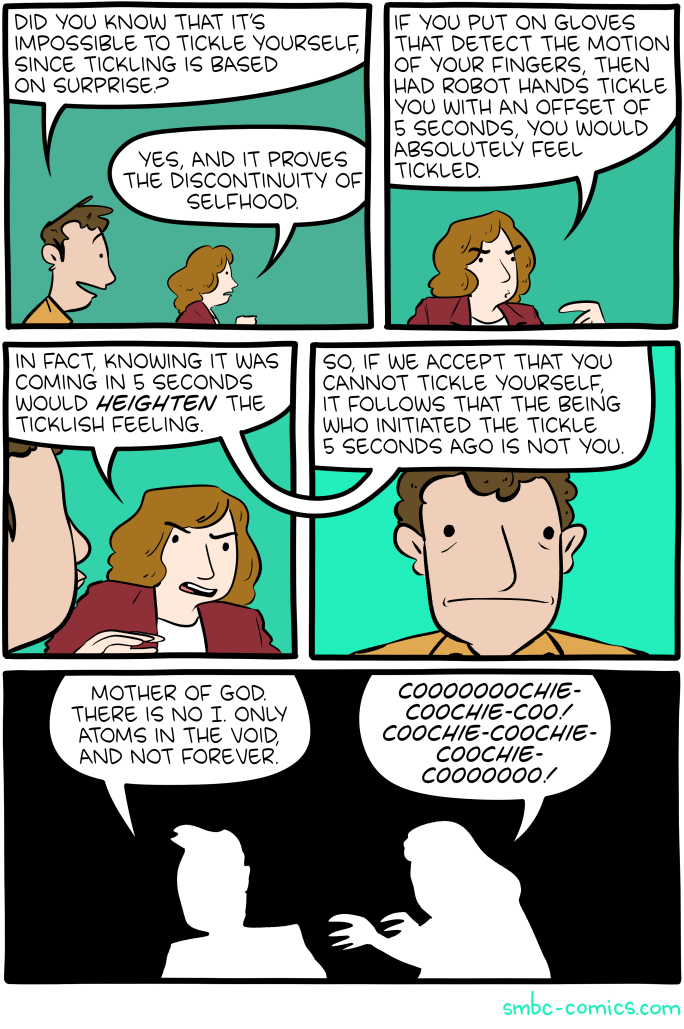
Click here to go see the bonus panel!
Hovertext:
First person to build and film the autotickler gets 3 SMBC points.
Today's News:



